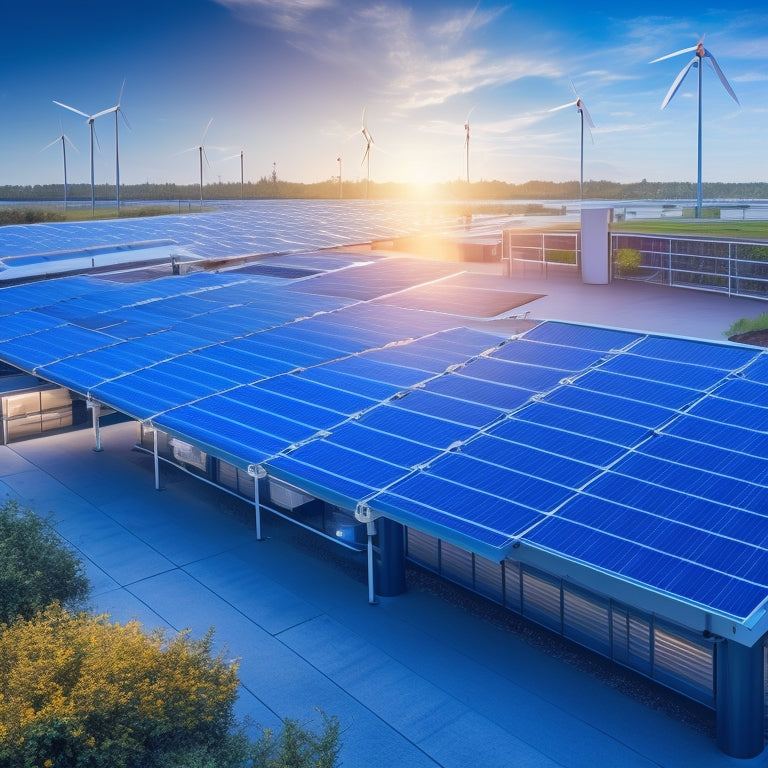
Storing Solar Energy for Business: A Step-by-Step Guide
Share
You're considering storing solar energy for your business, a smart move to reduce reliance on the grid and mitigate rising energy costs. To get started, you'll need to assess your energy usage patterns, determine peak demand periods, and evaluate overall energy consumption. Next, select a suitable battery type and compatible inverter system, ensuring efficient DC-DC conversion and monitoring features. Properly size your energy storage system, install components carefully, and configure them correctly. As you move forward, you'll discover the nuances of optimizing system performance, evaluating metrics, and more - let's take the next step together to unleash the full potential of solar energy for your business.
Key Takeaways
• Assess energy needs and system planning to identify peak demand periods and overall energy consumption.
• Select suitable batteries based on energy density, cost, and environmental impact, ensuring cost-effectiveness and efficiency.
• Match inverter rating with battery capacity, ensuring efficient DC-DC conversion and seamless integration with the energy storage system.
• Size and optimize the energy storage system accurately, considering peak usage, average consumption, and system complexity.
• Monitor battery health through calibration, warranty expiration tracking, cycle count, voltage levels, and temperature monitoring to ensure optimal performance.
Assessing Your Energy Storage Needs
To determine the right energy storage solution for your business, you need to assess your energy usage patterns, identifying the peak demand periods, overall energy consumption, and any potential grid instability or outage risks that may impact your operations.
Conducting an energy audit is an essential step in this process. It helps you understand your energy usage patterns, identifying areas of inefficiency and opportunities for improvement.
Load profiling is also vital, as it provides a detailed analysis of your energy consumption over time. By analyzing your energy usage patterns and load profiles, you can determine the best energy storage solution for your business, ensuring you have the power you need when you need it.
Choosing the Right Battery Type
With your energy usage patterns and load profiles in hand, you're now ready to select the best battery type for your business's energy storage needs. Choosing the right battery type is essential for maximizing energy storage and cost savings. Here's a comparison of four common battery types to help you make an informed decision:
| Battery Type | Characteristics |
| Lead-Acid | Low upfront cost, short battery lifespan (5-7 years) |
| Lithium-Ion | High energy density, long battery lifespan (10-15 years), high upfront cost |
| Nickel-Cadmium | High cycle life, moderate upfront cost, toxic materials |
| Sodium-Ion | Low cost, long battery lifespan (10-15 years), still in development |
Consider factors like battery lifespan, cost comparison, and environmental impact when selecting a battery type. By choosing the right battery type, you can ensure efficient energy storage and maximize your return on investment.
Selecting a Compatible Inverter System
Your battery selection is only as good as the inverter system that accompanies it, so you'll need to choose an inverter that seamlessly integrates with your chosen battery type. Inverter compatibility is vital to ensure efficient energy conversion and minimize system harmonics.
Here are key considerations for selecting a compatible inverter system:
- Inverter rating: Make sure the inverter's power rating matches your battery's maximum discharge capacity to avoid overheating and system failure.
- DC-DC conversion: Choose an inverter that can efficiently convert DC power from your batteries to AC power for your business.
- Monitoring and control: Select an inverter with built-in monitoring and control capabilities to optimize system performance and detect potential issues.
Sizing Your Energy Storage System
You'll need to carefully calculate the size of your energy storage system to make sure it can effectively meet your business's power requirements during periods of high demand or grid outages. This involves evaluating your energy demands, including peak usage and average consumption.
Consider the system complexity, including the type and number of batteries, inverters, and other components. A correctly sized system guarantees you'll have reliable power when you need it most.
Underestimating your energy needs can lead to power outages, while oversizing can result in unnecessary costs. By accurately calculating your energy storage needs, you'll be able to optimize your system's performance, reduce costs, and ensure business continuity.
Installing the Energy Storage System
During installation, the energy storage system's components, including batteries, inverters, and monitoring systems, must be carefully integrated to guarantee smooth operation and peak performance. As you oversee the installation process, make certain that each component is properly connected and configured to meet the specifications outlined in your System Design. This attention to detail will help prevent potential issues down the line.
Here are some key considerations to keep in mind:
-
Verify that all components are compatible and meet the necessary safety standards.
-
Confirm that the installation team has access to the site and necessary resources.
-
Conduct thorough testing to ensure the system is operating as intended, and make any necessary adjustments before finalizing the installation.
Integrating With Existing Infrastructure
Integrating the energy storage system seamlessly with your existing infrastructure is vital to maximize its potential and minimize disruptions. You'll need to assess your current infrastructure to identify areas that require upgrades or modifications to accommodate the new system.
This may involve infrastructure upgrades, such as installing new electrical panels or modifying your building's electrical layout. System integration is key to guaranteeing a smooth shift. You'll need to connect the energy storage system to your existing electrical infrastructure, including solar panels, generators, and the grid.
This requires careful planning and execution to ensure a seamless integration. By doing so, you'll be able to optimize your energy usage, reduce costs, and increase your reliance on renewable energy sources.
Monitoring and Maintaining the System
As your energy storage system becomes operational, it's essential to establish a monitoring and maintenance routine to guarantee peak performance, identify potential issues, and prevent unexpected downtime. This ensures maximum system uptime and minimizes revenue losses.
You should set up a monitoring system to track key performance indicators, such as energy output, battery health, and system temperature.
- Set alert thresholds for critical system parameters to receive timely notifications of potential issues.
- Regularly review system logs to identify trends and anomalies.
- Schedule routine maintenance tasks, such as software updates and component replacements, to prevent unexpected failures.
Optimizing Energy Storage Performance
As you optimize your energy storage system, you'll need to contemplate several key factors to guarantee peak performance.
You'll want to evaluate your system's configuration to make sure it's properly sized and integrated with your solar array.
System Configuration
You can greatly enhance the performance of your energy storage system by strategically configuring its components to optimize power output, depth of discharge, and charging/discharging cycles. This involves carefully selecting and arranging system components to guarantee seamless integration and maximum efficiency.
Here are some key considerations to keep in mind:
-
System Scalability: Guarantee your system can adapt to changing energy demands by selecting components that can be easily scaled up or down.
-
Load Balancing: Distribute energy storage capacity across multiple units to minimize the risk of overcharging or undercharging.
-
Component Compatibility: Verify that all system components are compatible to prevent system failures and optimize performance.
Energy Density Matters
By optimizing energy storage performance, you can maximize the efficiency of your system, and energy density plays a significant role in achieving this goal. Energy density refers to the amount of energy stored per unit of volume or mass.
Higher energy density means more energy can be stored in a smaller space, reducing costs and increasing energy efficiency. When selecting energy storage solutions, consider those with high energy density to optimize your system's performance. This will enable you to store more energy while minimizing space requirements, ultimately enhancing grid resilience.
Battery Health Checks
Regular battery health checks are crucial to optimizing energy storage performance, guaranteeing your system operates efficiently, and extends the lifespan of your batteries. By monitoring your batteries' state of health, you can identify potential issues before they escalate, preventing downtime and reducing maintenance costs.
Here are key aspects to focus on during battery health checks:
-
Battery Calibration: Verify that your batteries are calibrated correctly to guarantee accurate state of charge readings and peak performance.
-
Warranty Expiration: Keep track of your warranty's expiration date to make sure you're eligible for replacements or repairs if needed.
-
Cycle Count: Monitor the number of charge cycles to anticipate when battery replacement is necessary, ensuring uninterrupted operation.
Evaluating System Performance Metrics
As you evaluate your energy storage system's performance, you'll want to assess its energy yield and system efficiency ratings. These metrics will help you understand how well your system is generating and storing energy, and identify areas for improvement.
Energy Yield Assessment
Evaluating your solar energy system's performance requires a thorough energy yield assessment. This involves tracking and analyzing key metrics to guarantee peak energy production. This assessment helps you identify areas for improvement and optimize your system's performance.
Here are some key factors to take into account:
-
Solar Irradiance: Measure the amount of sunlight your system receives to ensure peak energy production.
-
Climate Modeling: Analyze local climate conditions to predict energy output and adjust your system accordingly.
-
System Performance Ratios: Calculate metrics such as capacity utilization and performance ratios to pinpoint areas for improvement.
System Efficiency Ratings
You can now assess the performance of your solar energy system by examining system efficiency ratings. These ratings provide a detailed picture of your system's ability to convert sunlight into usable energy.
These ratings are based on rating criteria that evaluate your system's efficiency in converting sunlight into electrical energy. Efficiency standards, such as those set by the International Electrotechnical Commission (IEC), provide a benchmark for evaluating your system's performance.
Frequently Asked Questions
Can I Use My Existing Electrical Infrastructure for Energy Storage?
You'll likely need an inverter upgrade and possibly an electrical retrofit to make sure your existing infrastructure can handle energy storage, so assess your system's capabilities before integrating energy storage solutions.
Are Energy Storage Systems Compatible With Grid-Tied Solar Systems?
You'll find that energy storage systems are indeed compatible with grid-tied solar systems, allowing you to optimize system sizing and maximize energy harvesting while ensuring a seamless grid tie operation.
Can I Charge My Energy Storage System From the Grid During Off-Peak Hours?
You can charge your energy storage system from the grid during off-peak hours, taking advantage of lower Time of Use rates, and use that stored energy to reduce peak demand and costs through Peak Shaving strategies.
Will an Energy Storage System Affect My Business's Power Quality?
You'll be pleased to know that a well-designed energy storage system won't compromise your business's power quality, ensuring reliable voltage stability and maintaining power reliability, even during peak hours or grid outages.
Are Energy Storage Systems Eligible for Federal and State Tax Credits?
You'll be pleased to know that energy storage systems are eligible for federal and state tax credits, offering attractive tax incentives that can substantially reduce your project's costs and boost your return on investment.
Related Posts
-
Trends in Renewable Energy Storage Technologies
You're witnessing rapid advancements in renewable energy storage technologies aimed at improving efficiency and scala...
-

Solar Power Savings for Environmentally Aware Consumers
Switching to solar power lets you drastically cut your carbon footprint while saving money in the long run. Each kilo...
-

Cost-Effective Solar Solutions for Rural Homes
Cost-effective solar solutions can alter your rural home by enhancing energy independence and slashing utility bills....

